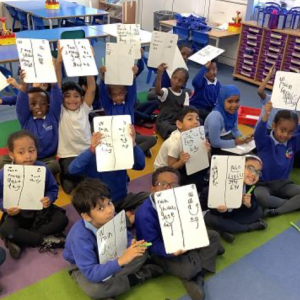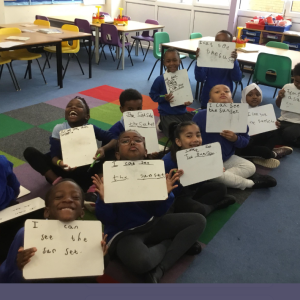Phonics at Easton
Intent
At Easton CE Academy, we teach phonics using a linguistic phonics programme called Sounds-Write. Sounds Write is a very highly structured, multi-sensory approach to teaching children to read and spell. The Sounds-Write programme is implemented in the classroom and provides very fast and effective teaching for children at all levels. This programme is successful in teaching children to read and spell because it starts with what all children know from a very young age – the sounds of our spoken language. Then, using a very systematic approach, it teaches them how these sounds are coded within our writing system.
Phonics is a non-negotiable part of our daily curriculum. Every child from Nursery to Year 2 has a daily phonics session lead by an adult who has experience teaching phonics and has been trained to deliver the scheme, Sounds-Write. We believe that every child is a reader and should be supported to develop a lifelong love of reading. Starting phonics in Nursery ensures we give all our children the very best possible start to life as a reader.
Implementation
Its structure and simplicity makes it a programme accessible to all learners and helps them to make excellent progress with their reading and spelling. Sounds-Write promotes the use of multi-sensory engagement with the materials appropriate to the level and abilities of the children being taught. Visual, auditory and kinaesthetic activities are at all times combined simultaneously to promote learning. In addition to being multisensory, the Sounds-Write programme has pace and utilises an array of stimulating lessons
and resources.
It also enables teachers to differentiate the challenges placed before the learner in order to meet their individual needs.
The four key concepts children are taught are:
1. letters are symbols that represent sounds
2. sounds can be spelled using 1, 2, 3 or 4 letters
3. the same sound can be spelled in different ways
4. the same spelling can represent different sounds
The three key skills children need to master are:
1. blending
2. segmenting
3. phoneme manipulation
How phonics is taught at Easton CE Academy EYFS and KS1
A 25-30 minute Sounds- Write lesson is a non-negotiable each day. Children in our Foundation Stage begin with the Initial Code where they practice all 3 key skills whilst learning the 1:1 sound-spelling correspondences and securing their understanding of key concept 1. This builds up confidence and phonic knowledge in a truly reversible system, enabling them to decode and encode a wide range of words and sentences. At first, children learn to read and write simple one syllable words with a CVC structure. Complexity of word
structure systematically builds up so that children apply their code knowledge to monosyllabic words with up to six sounds.
Once the Initial Code has been mastered, children continue to practice all three key skills whilst learning Extended Code which explores key concepts 2, 3 and 4. Learning of the Extended Code is a lifelong process – we all continue to develop our understanding of this code whenever we encounter new words.
Lesson Structure
A typical Sounds- Write lesson is broken up into 3 parts. These three specific parts can be
taught in any order within a unit of study.
Phonics is also embedded across the curriculum, such as during a Literacy session, children working independently might be given a phonics activity to write or read. During a shared write or in a teachers input, the teacher might require the class to all decode some words together or ask the children how to spell a decodable word. The teacher aims to choose words/characters with decodable names so that the children can try to be as independent in their writing as possible.
Across Reception and KS1, children are also given decodable reading books that is at least 2 units behind of the current unit in class. The decodable readers (Dandelion Launchers, Dandelion Readers and Sounds-Write Books) match the progression of sounds taught in Sounds- Write.
Reception and Year 1 children solely use these books throughout the year to support their independent decoding skills and gradually move up the units as their ability increases, this is up to the teacher and TA to assess and decide. Some children in Year 1 and Year 2 who are reading fluently will have a phonics reader alongside another book at their level.
Assessment
Reception assess children using the Sounds write Diagnostic Tests when needed. This assesses the children on their oral blending, oral segmenting, initial sounds and ability to segment and blend 14 words using the sounds children have been taught. At the end of Term 1, the children are assessed on initial sounds and the high frequency words that they have been taught. This gives the teacher an overview of their sound recognition after a few weeks of teaching. Each term there are termly assessments focused on the learning that has been taught that term.
After each phonics assessment, the team analyses the data collated, taking a forensic approach to identifying the need of the co-hort and where the teaching of phonics needs to address. This enables staff to take a bespoke approach to individual needs, ensuring no child is left behind and each child is appropriately challenged.
Year 1 and 2 have a rigorous approach to assessment by carrying out a termly assessment of taught code based on the sounds the children have been taught. In addition, from Term 3 ‘mock phonics screening checks’ are also introduced. A phonics tracker is used to enable staff to see which children are making good and outstanding progress and which children are in need of some intervention to ensure they make good progress. Children who are SEN and require adapted phonics sessions are also identified. These children will also receive extra phonics support with daily reading ensure they can access the session and it is having the maximum impact for that child.
Interventions
Interventions are carefully planned to support those children who could potentially fall behind or need some extra support to enable them to keep up with their peers. These are intentionally planned by the Teaching Team Leader and delivered by a class teaching assistant or teacher who knows the children well and has experience of delivery phonics. We are using a keep up/ catch up approach through targeted intervention.

